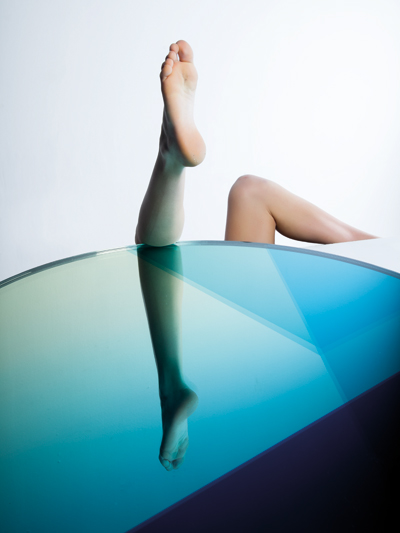|
|
||
|
The designer’s experiments in transparency embrace tables, lights and even backpacks, Peter Smisek reports One of the first things Sabine Marcelis admits to is having “itchy feet syndrome”: never living anywhere longer than six years. Proof? After two years of industrial design in New Zealand, she transferred to the legendary Design Academy Eindhoven in pursuit of greater freedom in her education and to indulge her curiosity in her favourite material.
The Voie series of neon lights is cast in polyester resin
Big Round from the Seeing Glass series (with Brit van Nerven) “Glass fascinates me. It’s transparent, and you can layer it to create different effects. I did a lot of glass-blowing before, but during my graduation my focus became much more technical,” she confesses. As a result, her 2011 graduation project, Table-Table, in which a laminated-glass tabletop with variable transparency reveals office stationery and books hidden inside, continues to inform much of her work to this day. “I need to satisfy my own fascinations, and I’d rather not be restricted by budgets, or production costs, which is not always viable in a commercial setting,” she explains. Teaming up with art galleries, she is able to produce experimental work, such as her limited edition Voie and Dawn light series, in which neon tubes are cast into coloured resin elements, exploring the subtle interaction of the two components. But she doesn’t shy away from collaboration either: her Seeing Glass series consists of layered and polychromatic glass objects, designed in tandem with Brit van Nerven and a glass manufacturer.
The highly polished Candy Cubes series
Pink Cube at Céline, avenue Montaigne, Paris No wonder then that Marcelis’s work successfully finds its way into commercial settings: she produced a series of resin display cubes for Céline in 2014, and reimagined an Eastpak backpack in iridescent plastic. Her other clients include Stella McCartney, the municipality of Rotterdam and the jewellery house Repossi. She cannot yet reveal details of her latest venture, apart from its “steep learning curve” and the work’s “large-scale, high-risk, high-reward nature”. But she does confess that she would like to work more with architects and interior designers, putting her artful installations to more prosaic use. 2016 might just be the year to see it happen.
Seeing Glass explored colour through layered optical effects |
Words Peter Smisek |
|
|
||

























